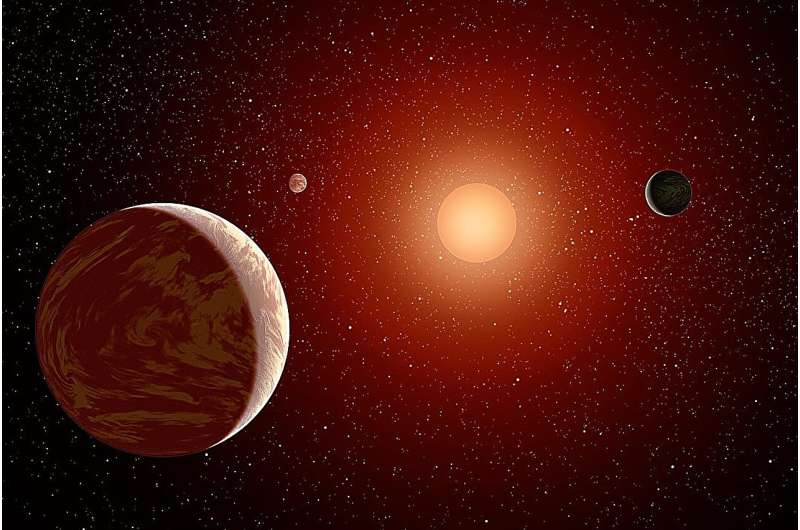In the vast cosmic ocean, our understanding of planetary formation is constantly evolving. Just when we think we’ve got it figured out, the universe throws us a curveball. The latest pitch? A hefty gas giant orbiting a petite red dwarf star in a binary system. This discovery is not just breaking records; it’s shattering our preconceptions about how planets form around the galaxy’s most numerous stars.

The Tiny Titans of the Cosmos
Red dwarf stars, also known as M-dwarfs, are the unsung heroes of the Milky Way. These stellar runts make up a whopping 75% of all stars in our galaxy, yet they often fly under the radar due to their small size and dim glow. Despite their diminutive nature, these cosmic embers are proving to be veritable planet factories, churning out worlds that range from small, rocky planets to gas giants that rival Jupiter in size.
The NASA Exoplanet Archive has been instrumental in cataloging these discoveries, showcasing the diversity of planetary systems around red dwarfs. But it’s the recent finding in the TOI-6383 system that’s turning heads in the astronomical community.
A Tale of Two Stars and a Giant
Enter TOI-6383, a binary star system located about 560 light-years from Earth. This cosmic duo consists of two red dwarf stars: TOI-6383A, weighing in at 46% of our Sun’s mass, and its smaller sibling, TOI-6383B, at a mere 20.5% solar mass. But the real star of the show (pun intended) is the newly discovered planet orbiting TOI-6383A.
This gas giant, dubbed TOI-6383Ab, is giving astronomers pause. With a mass and size comparable to Jupiter, it’s orbiting its host star at a breakneck pace, completing a lap every 1.79 days. To put that in perspective, it’s zipping around its star faster than you can say “planetary formation conundrum.”
The GEMS of Discovery
This planetary revelation comes courtesy of the Searching for Giant Exoplanets around M-dwarf Stars (GEMS) survey. Led by Lia Marta Bernabò, a Ph.D. student with a foot in both the University of Texas at Austin and the German Aerospace Center, the GEMS team is on a mission to unravel the mysteries of planet formation around red dwarfs.
Using NASA’s Transiting Exoplanet Survey Satellite (TESS), along with ground-based telescopes, the team employs the transit method to detect these elusive worlds. This technique involves watching for tiny dips in a star’s brightness as a planet passes in front of it – like a cosmic eclipse on repeat.
A Planetary Puzzle
The discovery of TOI-6383Ab isn’t just another notch in the exoplanet belt. It’s a puzzle piece that doesn’t quite fit with our current understanding of planetary formation. Traditionally, astronomers have relied on two main theories to explain how planets come to be:
- The core-accretion model: Think of this as a cosmic snowball effect. Tiny particles in a protoplanetary disk stick together, gradually building up to form a planet.
- The rapid formation model: This is more of a “cosmic shortcut” where a massive protostellar disk breaks apart under its gravity, forming planetary clumps.
The problem? Neither of these models easily explains the formation of a Jupiter-sized planet around a star as small as TOI-6383A. Red dwarfs typically have less massive protoplanetary disks, which should make it challenging to form giant planets according to the core-accretion model. Yet, here we are, with TOI-6383Ab defying expectations.
A Growing Trend
TOI-6383Ab isn’t alone in its rule-breaking ways. To date, astronomers have detected about 20 massive exoplanets orbiting M-dwarf stars. While that might not sound like a lot, consider that these discoveries are pushing the boundaries of what we thought possible.
The Planetary Habitability Laboratory at the University of Puerto Rico at Arecibo has been tracking these discoveries, providing valuable insights into the potential for life around red dwarf stars. While massive gas giants like TOI-6383Ab aren’t likely candidates for life as we know it, their presence could influence the habitability of other planets in these systems.
Rewriting the Cosmic Rulebook
As the GEMS survey continues its celestial census, aiming to bump up the tally of known massive exoplanets around M-dwarfs to at least 40, astronomers are gearing up for a potential paradigm shift. Each discovery is a data point that could lead to refined theories or entirely new models of planetary formation.
Dr. Jane Greaves, an astronomer at Cardiff University not involved in the study, commented on the implications of such discoveries: “These findings are forcing us to reconsider our models of planet formation. We may be seeing the results of a different formation mechanism around red dwarfs, or perhaps these stars are more efficient at forming planets than we previously thought.”
The Cosmic Perspective
As we continue to explore the galaxy through projects like GEMS and missions like TESS, we’re reminded of the incredible diversity of the cosmos. The European Space Agency’s PLATO mission, set to launch in 2026, promises to further expand our exoplanet catalog, potentially uncovering even more planetary surprises.
These discoveries do more than just fill in gaps in our astronomical knowledge. They spark our imagination, challenging us to think beyond our solar system and consider the vast possibilities for planetary systems – and potentially life – in the universe.
As we gaze up at the night sky, let’s remember that those faint red dots we can barely see might be host to some of the most intriguing planetary systems in our galaxy. The universe, it seems, has a penchant for surprises, and red dwarfs might just be its favorite messengers.
So, the next time you hear about a new exoplanet discovery, pay attention. It might just be the clue that helps us solve the cosmic puzzle of planetary formation. After all, in the words of Carl Sagan, “Somewhere, something incredible is waiting to be known.”
